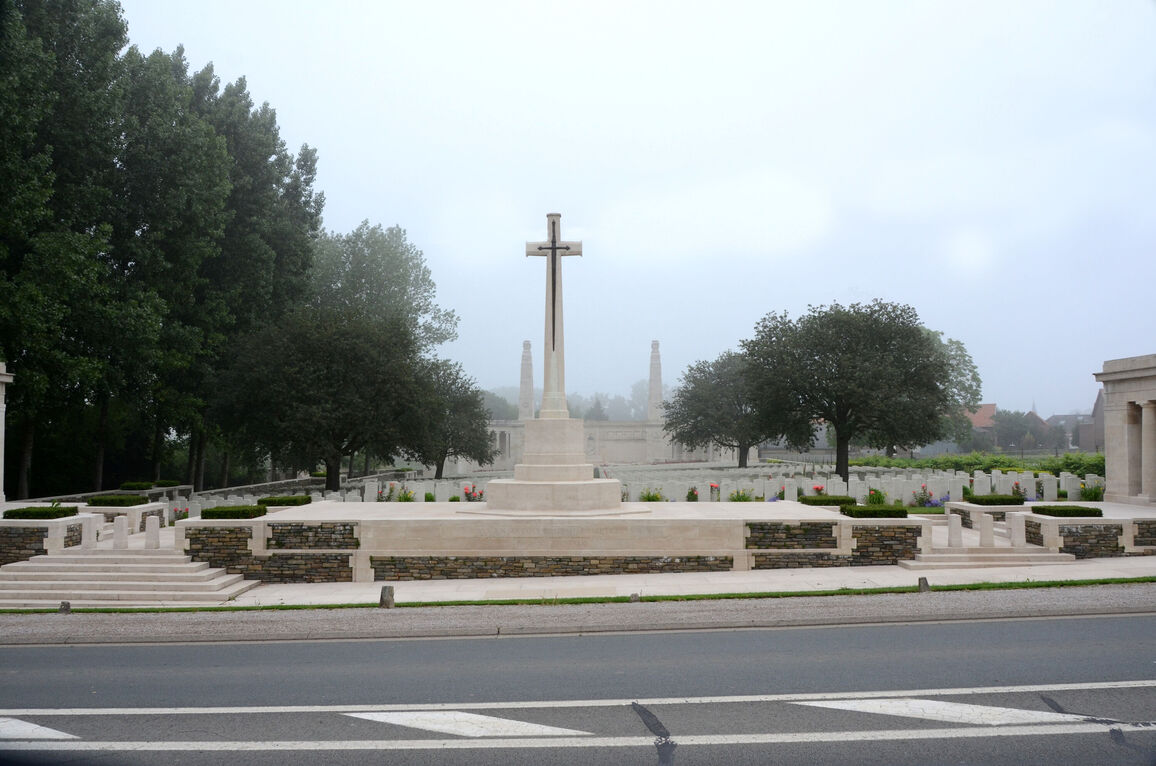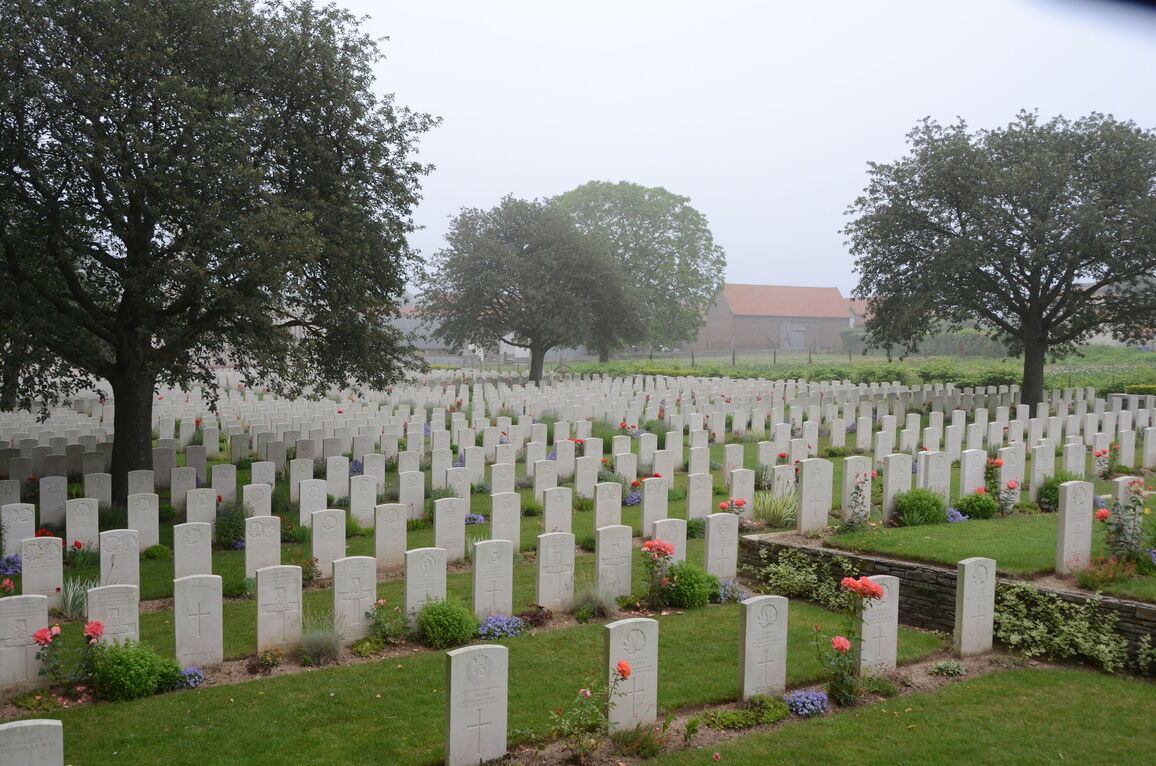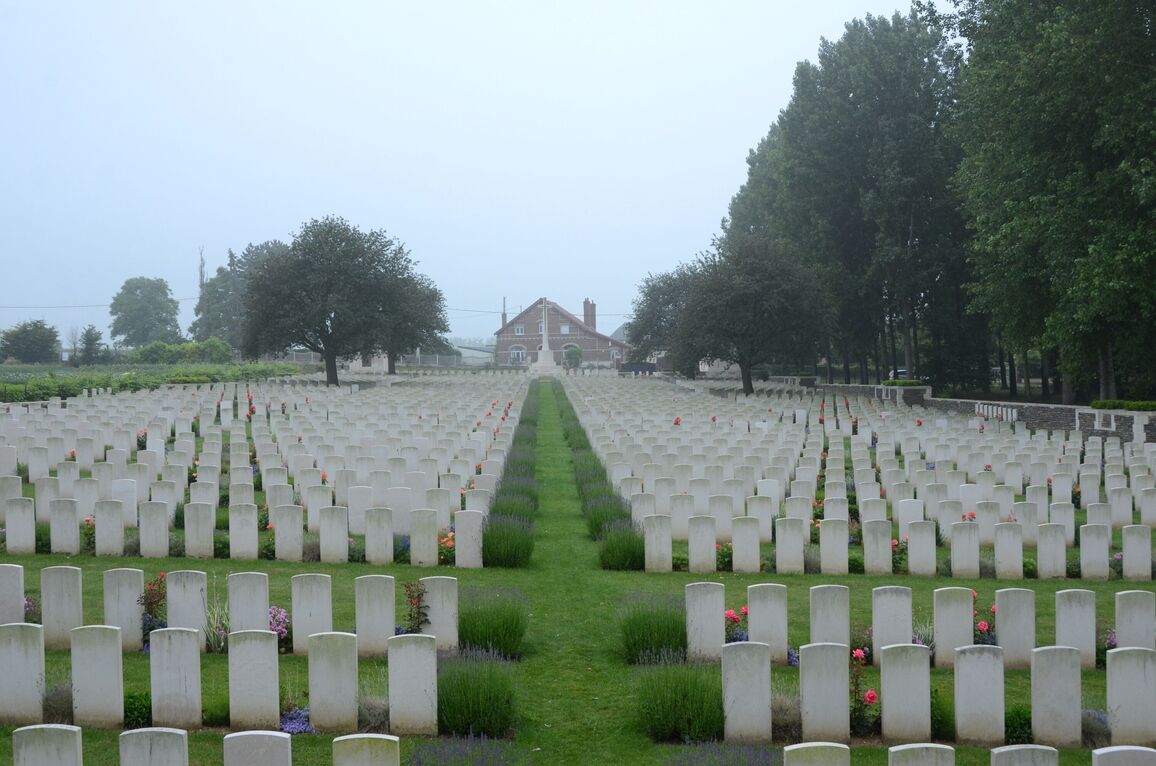Vis-En-Artois British Cemetery, Haucourt
- Country France
- Total identified casualties 891 Find these casualties
- Region Pas de Calais
- Identified casualties from First World War
- GPS Coordinates Latitude: 50.24574, Longitude: 2.94982
Location information
Vis-en-Artois and Haucourt are villages in the Department of the Pas-de-Calais, on the road from Arras to Cambrai.
The Cemetery is at the north side of the main road between the two villages.
Visiting information
PARKING
There is parking in the layby area in front of the cemetery, where there is space for approximately six vehicles.
The layby is sloped and has a loose gravel surface.
ACCESS, MAIN ENTRANCE AND LAYOUT
The cemetery is laid out in a rectangular shape with the memorial located at the rear of the cemetery.
There are three steps on the right-hand side of the main entrance and six on the left-hand side. All steps lead up to the cemetery and require passing though stone bollards (approximately 500mm between each bollard) and lead to a raised stone platform. Further steps (2 to 4) lead to either the cemetery, Shelter Buildings or the Cross of Sacrifice, located on the central platform.
The two Shelter Buildings have seating areas inside, with the Register Box for the cemetery located in the left shelter. The raised platforms are up to 1 m above ground level.
All internal paths are flat and grass, with the ground sloping downwards towards the rear of the cemetery.
A Stone of Remembrance is located centrally at the rear of the cemetery on a raised platform in front of the memorial. The edge of the Stone of Remembrance structure is approximately 1 m above the ground level.
The Vis-en-Artois Memorial is a large, stone monument with engraved stone panels.
Access from the cemetery to the memorial is by climbing stone steps from two points which lead up to the memorial from the cemetery. There are additional steps leading up into either side of the Memorial.
The Register Box for the Memorial is located in the left-side shelter building of the Memorial.
An additional stone bench located in the left-side wall, close to the Memorial.
ALTERNATIVE ACCESS
At the main entrance and marked with a signpost, is the route to an alternative access entrance.
The route is along a firm, grass path which follows the boundary wall along the right-hand side of the cemetery.
At the end of the path is a metal gate approximately 1.5 m wide that opens into the cemetery.
ADDITIONAL INFORMATION
Vis-En-Artois Memorial and Cemetery are permanently open.
History information
Vis-En-Artois and Haucourt were taken by the Canadian Corps on 27 August 1918. The cemetery was begun immediately afterwards and was used by fighting units and field ambulances until the middle of October. It consisted originally of 430 graves (in Plots I and II) of which 297 were Canadian and 55 belonged to the 2nd Duke of Wellington's Regiment. It was increased after the Armistice by the concentration of graves from the battlefields of April-June 1917, August and September 1918, and from the smaller cemeteries in the neighbourhood, including:-
BOIS-DU-SART BRITISH CEMETERY, PELVES, at the North-Western angle of the Bois-du-Sart, which contained the graves of ten soldiers and airmen from the United Kingdom and nine soldiers from Canada who fell in August and September 1918.
DURY GERMAN CEMETERY was on the South-East side of Dury village, a little South of the road to Saudemont. It contained the graves of four British and 49 German soldiers.
ECOURT-ST. QUENTIN GERMAN CEMETERY on the East side of the road to Lecluse. It contained the graves of 16 soldiers from the United Kingdom.
ETAING COMMUNAL CEMETERY GERMAN EXTENSION, which contained the graves of six soldiers and airmen from the United Kingdom, who fell in 1917 and 1918, 331 German soldiers (including some who fell in August 1914), and two Russian prisoners.
LECLUSE GERMAN CEMETERY, on the West side of the village, contained the graves of 476 German soldiers, eleven soldiers from the United Kingdom who fell in 1917, and one Russian prisoner.
MONCHY QUARRY CEMETERY was in a quarry 800 metres South-East of Monchy-le-Preux. It contained the graves of 22 soldiers from the United Kingdom who fell in July 1917.
PELVES CANADIAN CEMETERY, nearly 1.6 kilometres due South of the village, contained the graves of 39 soldiers from Canada who fell in August and September 1918.
PELVES COMMUNAL CEMETERY GERMAN EXTENSION, which contained the graves of two soldiers from the United Kingdom who fell in 1917.
RUMAUCOURT GERMAN CEMETERY, on the Southern edge of the village, which contained the graves of 21 soldiers from the United Kingdom and six from Australia.
SAILLY-EN-OSTREVENT COMMUNAL CEMETERY, which was destroyed by shell-fire, contained the graves of three soldiers from the United Kingdom (two of which were recovered).
VIS-EN-ARTOIS COMMUNAL CEMETERY GERMAN EXTENSION, which was very badly shelled, contained the graves of 621 German soldiers, 14 from the United Kingdom, eight French and five Russian.
The cemetery now contains 2,369 burials and commemorations of the First World War. 1,458 of the burials are unidentified but there are special memorials to eight casualties known or believed to be buried among them. Other special memorials commemorate four soldiers buried in other cemeteries whose graves could not be found on concentration.
The cemetery was designed by J R Truelove.






